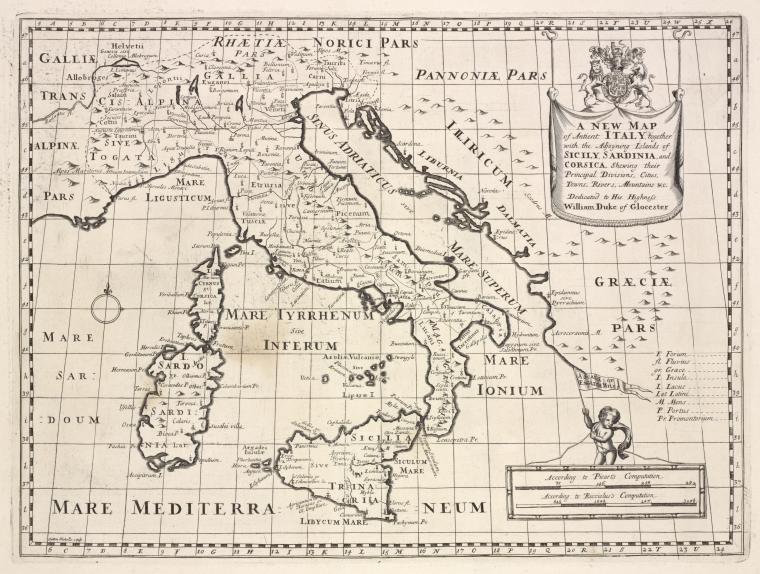Strait of Sicily
Linosa
Linosa is a small volcanic island in the Strait of Sicily, which along with Lampedusa and Lampione make up the Pelagie Islands. In 1957, Raimondo Bucher, the celebrated underwater explorer, discovered the ruins of what he considered to be remnants of an ancient civilisation in the vicinity of Linosa. He speculated on a possible link with Atlantis noting “that the legend of Atlantis handed down by the Greeks just talk about a land that, in past centuries would have to be in the region of North Africa and Sicily.”(a)
Pelagie Islands. In 1957, Raimondo Bucher, the celebrated underwater explorer, discovered the ruins of what he considered to be remnants of an ancient civilisation in the vicinity of Linosa. He speculated on a possible link with Atlantis noting “that the legend of Atlantis handed down by the Greeks just talk about a land that, in past centuries would have to be in the region of North Africa and Sicily.”(a)
(a) https://fortunadrago.wordpress.com/the-never-ending-story/colonello-c-cattoi/raimondo-bucher/
Landbridges
Landbridges, in biogeography, are described by Wikipedia as “an isthmus or wider land connection between otherwise separate areas, over which animals and plants are able to cross and colonize new lands. A land bridge can be created by marine regression, in which sea levels fall, exposing shallow, previously submerged sections of continental shelf; or when new land is created by plate tectonics; or occasionally when the sea floor rises due to post-glacial rebound after an ice age.”
In the distant past, landbridges are believed to have played a critical part in early human migration. Similarly, 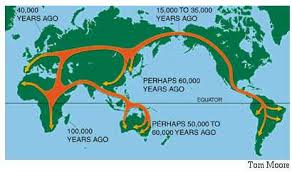 landbridges, both real and speculative are important components in many Atlantis theories. There is no doubt that the ending of the last Ice Age and the consequent rising sea levels led to the creation of islands where continuous land has previously existed. The separation of Ireland and Britain from each other and from mainland Europe is just one example, the latter leading to a number of writers identifying ‘Doggerland‘, which lay between Britain and Denmark as the home of Atlantis.
landbridges, both real and speculative are important components in many Atlantis theories. There is no doubt that the ending of the last Ice Age and the consequent rising sea levels led to the creation of islands where continuous land has previously existed. The separation of Ireland and Britain from each other and from mainland Europe is just one example, the latter leading to a number of writers identifying ‘Doggerland‘, which lay between Britain and Denmark as the home of Atlantis.
>The two most discussed landbridges were at the Bering Strait, where it is thought that it provided the gateway for humans to enter the Americas from Asia and an Atlantic landbridge, which was proposed as early as the 17th century when Francois Placet, a French abbot, who, in 1668, wrote “The break up of large and small world’s, as being demonstrated that America was connected before the flood with the other parts of the world.” A Scientific American article relates how “He argued that the two continents were once connected by the lost continent of “Atlantis” and the flood of the bible separated them.” (d)<
Later by John B. Newman in 1849 [488.8], who wrote that “in former times an island of enormous dimensions, named Atlantis, stretched from the north-western coast of Africa across the Atlantic ocean and that over this continental tract both man and beast migrated westward.“
>Charles Frédéric Martins was a French botanist and geologist who was so intrigued by the similarity of geology as well as plant species on the Azores, Spain and Ireland that he suggested in his 1866 book, Du Spitzberg Au Sahara [1440],that these were physically linked in the distant past and that they may have been part of Atlantis(c).
Martins also said, in the Revue des Deux Mondes for March 1, 1867, “Now, hydrography, geology, and botany agree in teaching us that the Azores, the Canaries, and Madeira are the remains of a great continent which formerly united Europe to North America.”<
The Atlantic landbridge idea became quite popular by the end of the 19th and beginning of the 20th centuries and even as late as the 1970s when espoused by Rene Malaise(a), but is now completely abandoned. Ignatius Donnelly referred to such a landbridge as a ‘connecting plateau’ linking Europe, Africa and America that allowed plants and animals to cross in both directions.
Although there was only one suggestion that the Bering Strait was in any way connected with Plato’s Atlantis, several commentators identified an Atlantic landbridge as the ideal location for Plato’s Atlantis, particularly as he placed it in the Atlantic Sea. However, this should not be confused with the Atlantic Ocean, a word that had an entirely different meaning for the ancient Greeks.
The idea was initially put forward in order to explain the floral and faunal similarities shared by the Old World and the New World of the Americas. The hypothetical Atlantic landbridges or a series of steppingstone islands. also offered possible routes for the peopling of the Americas by Europeans and/or Africans. It was not long before the discovery of the Mid-Atlantic Ridge(b) seemed to confirm this idea. Then it was suggested that Atlantis existed on this landbridge, which was destroyed by rising sea levels after the last Ice Age, leaving just the Azores, Madeira and a few other islands as remnants.
A number of landbridges have been proposed for the Mediterranean and linked to a variety of Atlantis theories, the most notable being proposed for the straits of Gibraltar, Sicily, Messina and Bonifacio. Although it is evident that landbridges existed at most of these locations, to associate them with any particular Atlantis theory requires that the date of their existence is compatible with Plato’s narrative.
Less popular theories have been constructed involving landbridges in locations, such as the Caribbean and Indonesia.
(a) Atlantis, Vol.27, No.1, Jan-Feb 1974.
(b) From the Contracting Earth to early Supercontinents – Scientific American Blog Network
Italy
Italy seems to have an uncertain etymology; Thucydides claims that Italos, the Sicilian king gave his name to Italy, while more recently Emilio Spedicato(h) considers that ”the best derivation we believe to be the one proposed by the Italian nuclear engineer Felice Vinci (1998), in his monograph claiming a Baltic setting for the Homeric epic: he derives Italia from the rare Greek word aithalia, meaning the smoking one.” This is thought to be a reference to Italy’s many volcanoes.
Italy today is comprised of territory south of the Alps on mainland Europe including a very large boot-shaped peninsula, plus Sicily, Sardinia and some smaller island groups, which along with the French island of Corsica virtually enclose the Tyrrhenian Sea.
The earliest proposal that Italy could be linked with Atlantis came from Angelo Mazzoldi in 1840 when he claimed that before Etruria, Italy had been home to Atlantis and dated its demise to 1986 BC. Mazzoldi expressed a form of hyperdiffusion that had his Italian Atlantis as the mother culture which seeded the great civilisations of the eastern Mediterranean region(b).
Some of Mazzoldi’s views regarding ancient Italy were expanded on by later scholars such as Camillo Ravioli, Ciro Nispi-Landi, Evelino Leonardi, Costantine Cattoi, Guido DiNardo and Giuseppe Brex. Ravioli sought to associate the Maltese island of Gozo with his proposed Atlantis in Italy.
The Italian region of Lazio, which includes Rome, has had a number of very ancient structures proposed as Atlantean; Monte Circeo (Leonardi) and Arpino(a) (Cassaro). Another aspect of Italian prehistory is the story of Tirrenide, which was described as a westward extension of the Italian landmass into the Tyrrhenian Sea during the last Ice Age, with a land bridge to a conjoined Sardinia and Corsica. At the same time, there were land links to Sicily and Malta, which were all destroyed as deglaciation took place and sea levels rose.
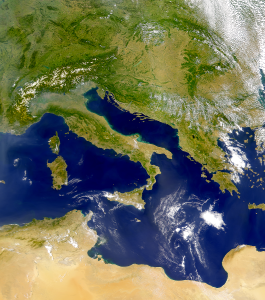 It is surprising that so few researchers have commented on Italy’s part in Plato’s Atlantis narrative considering that he twice, without any ambiguity, informs us that the Atlantean domain extended as far as Tyrrhenia (modern Tuscany).
It is surprising that so few researchers have commented on Italy’s part in Plato’s Atlantis narrative considering that he twice, without any ambiguity, informs us that the Atlantean domain extended as far as Tyrrhenia (modern Tuscany).
Crit.114c. So all these, themselves and their descendants dwelt for many generations bearing rule over many other islands throughout the sea and holding sway besides, as was previously stated, over the Mediterranean peoples as far as Egypt and Tuscany. Tim.25a/b. Now in this island of Atlantis there existed a confederation of kings, of great and marvellous power, which held sway over all the island, and over many other islands also and parts of the continent; and, moreover, of the lands here within the Straits they ruled over Libya as far as Egypt, and over Europe as far as Tuscany. (Bury)
The quotation from Timaeus is most interesting because of its reference to a ‘continent’. Some have understandably but incorrectly claimed that this is a reference to America or Antarctica, when quite clearly it refers to southern Italy as part of the continent of Europe. Moreover, Herodotus is quite clear (4.42) that the ancient Greeks knew of only three continents, Europe, Asia and Libya.
Philo of Alexandria (20 BC-50 AD) in his On the Eternity of the World(g) wrote “Are you ignorant of the celebrated account which is given of that most sacred Sicilian strait, which in old times joined Sicily to the continent of Italy?” (v.139).>The name ‘Italy’ was normally used until the third century BC to describe just the southern part of the peninsula(e).<Some commentators think that Philo was quoting Theophrastus, Aristotle’s successor. This would push the custom of referring to Italy as a ‘continent’ back near to the time of Plato. More recently, Armin Wolf, the German historian, when writing about Scheria relates(f) that “Even today, when people from Sicily go to Calabria (southern Italy) they say they are going to the ‘continente’.” This continuing usage is further confirmed by a current travel site(d) and by author, Robert Fox[1168.141]. I suggest that Plato used the term in a similar fashion and can be seen as offering the most rational explanation for the use of the word ‘continent’ in Timaeus 25a.
When you consider that close to Italy are located the large islands of Sicily, Sardinia and Corsica, as well as smaller archipelagos such as the Egadi, Lipari and Maltese groups, the idea of Atlantis in the Central Mediterranean can be seen as highly compatible with Plato’s description.
If we accept that Plato stated unambiguously that the domain of Atlantis included at least part of southern Italy and also declared that Atlantis attacked from beyond the Pillars of Heracles, then this appellation could not be applied at that time to any location in the vicinity of the Strait of Gibraltar but must have been further east, probably not too far from Atlantean Italy. This matches earlier alternative locations recorded by classical writers who placed the ‘Pillars’ at the straits of Messina or Sicily. I personally favour Messina, unless there is stronger evidence that some of the islands in or near the Strait of Sicily such as the Maltese or Pelagian Islands or Pantelleria were home to the ‘Pillars’.
(a) http://www.richardcassaro.com/hidden-italy-the-forbidden-cyclopean-ruins-of-giants-from-atlantis
(b) Archive 2509P (Eng) Archive 2943 (Ital)
(c) Archive 2946
(d) Four Ways to Do Sicily – Articles – Departures (archive.org)
(e) https://profilbaru.com/article/Name_of_Italy *
(f) Wayback Machine (archive.org)
(g) http://www.earlychristianwritings.com/yonge/book35.html
(h) http://2010-q-conference.com/ophir/ophir-27-10-09.pdf
Tyrrhenian Sea
>The Tyrrhenian Sea according to Massimo Pittau was named after the Sardinian Nuragics, since in ancient Greek ‘Tyrrenoi’ means ‘builders of towers’. As noted elsewhere, Sardinia was an important part of the Atlantean domain.<
Plato clearly states that Atlantis controlled Europe as far as Tyrrhenia (Critias 114c), which implies that they dominated the southern half of the Italian peninsula. The Sea is surrounded by the islands of Corsica, Sardinia, Sicily and the Lipari Islands as well as continental Europe in the form of the Italian mainland. Not only does it contain islands with an adjacent continent (see Timaeus 24e). It is also accessed through the straits of Messina and Sicily, both of which have been identified as locations for the Pillars of Heracles before Eratosthenes applied that appellation to the region of Gibraltar.
Timaeus 24e-25a as translated by Bury reads “there lay an island which was larger than Libya and Asia together; and it was possible for the travellers of that time to cross from it to the other islands, and from the islands to the whole of the continent over against them which encompasses that veritable ocean (pontos=sea). For all that we have here, lying within the mouth of which we speak, is evidently a haven having a narrow entrance; but that yonder is a real ocean (pelagos=sea), and the land surrounding it may most rightly be called, in the fullest and truest sense, a continent.” Similarly, Lee and Jowett have  misleadingly translated both pontos and pelagos as ‘ocean’, while the earliest English translation by Thomas Taylor correctly renders them as ‘sea’. Modern translators such as Joseph Warren Wells and a Greek commentator George Sarantitis are both quite happy to agree with Taylor’s translation. However, Peter Kalkavage translates pontos as ‘sea’ but pelagos as ‘ocean’!
misleadingly translated both pontos and pelagos as ‘ocean’, while the earliest English translation by Thomas Taylor correctly renders them as ‘sea’. Modern translators such as Joseph Warren Wells and a Greek commentator George Sarantitis are both quite happy to agree with Taylor’s translation. However, Peter Kalkavage translates pontos as ‘sea’ but pelagos as ‘ocean’!
For me, there is a very strong case to be made for identifying the Tyrrhenian Sea as the ‘sea’ referred to by Plato in the passage quoted above. However, it was probably F.Butavand, in 1925, who first proposed the Tyrrhenian as the sea described by Plato in his La Veritable Histoire de L’Atlantide[205] .
Pushing the boat out a little further, I note that Rome is situated in Central Italy and by tradition was founded by the twins Romulus and Remus!
A 1700 map of the Tyrrhenian Sea is available online.
‘Tyrrhenia’ is sometimes used as a geological term to describe a sunken landmass in the Western Mediterranean Basin(b)(c).
(a) (link broken) *
Krupa, Thomas J.
Thomas J. Krupa (1930- ) is the author of Biblical Flood, Noah’s Ark and the Star of David [1010] , in which he makes a number of startling claims. The book begins with an attack on the theory of plate tectonics. He then moves on to the opening of Drake Passage(a), conventionally considered to have taken place around 40 million years, but dated by Krupa to just 29,000 years ago, eventually leading to the ending of the Ice Age.
He also proposes the existence of an isthmus or landbridge between Sicily and North Africa and that the limestone structure was weakened by the rising Atlantic and rain erosion and finally fractured by an earthquake, which led to the flooding of the Black Sea and further afield. He then contends that a backwash from this flooding created the Strait of Messina.
He believes that this Sicilian isthmus “is a stronger contender for the location of Atlantis than every other place that I am aware of.”
Krupa then moves on to discuss Noah’s* Ark, which he claims had a keel shaped like the Star of David and furthermore that the ‘Star’ was incorporated in the design of Stonehenge! Coincidentally, Robert John Langdon has also linked the hexagram or Star of David with the layout of Stonehenge(b).
Advancing to even more contentious matters he maintains that the Kaaba in Mecca is intended as a replica of the Ark and to crown it all that Alexander the Great is buried within the Kaaba!!!
(a) https://en.wikipedia.org/wiki/Drake_Passage
(b) https://robertjohnlangdon.blogspot.co.uk/2014/06/quantum-of-solstice.html
Bardanzellu, Federico *
Federico Bardanzellu (1954- ) is a Roman researcher(a) with a special interest in Mediterranean prehistory. His ‘Dolmen Museum’ website(b) has particular relevance for Atlantology, as in it he discusses, in some detail, the Sea Peoples(c) and their connection with Sardinia, Corsica and Sicily as well as the Italian mainland. He claims that Homer’s Odysseus did not sail in the Okeanos beyond Gibraltar but instead voyaged in the Tyrrhenian Sea. He identifies Tarshish with the Sardinian Tharros and places the Pillars of Hercules in the Strait of Sicily on the island of Motya off the west coast of Sicily. Although he refers to Sergio Frau’s location for the ‘Pillars’ he does not specifically mention Atlantis.
some detail, the Sea Peoples(c) and their connection with Sardinia, Corsica and Sicily as well as the Italian mainland. He claims that Homer’s Odysseus did not sail in the Okeanos beyond Gibraltar but instead voyaged in the Tyrrhenian Sea. He identifies Tarshish with the Sardinian Tharros and places the Pillars of Hercules in the Strait of Sicily on the island of Motya off the west coast of Sicily. Although he refers to Sergio Frau’s location for the ‘Pillars’ he does not specifically mention Atlantis.
Bardanzellu has also published a book on the earliest inhabitants of Italy entitled Gli Antenati Che Vennero dal Mare[1017].
Although his website has not been updated for over a decade it does include an interesting study of possible astronomical significance that might be deduced from the orientation of the dolmens on both Corsica and Sardinia.(d)
(a) Federico Bardanzellu Home Page (archive.org) *
(b) http://www.museodeidolmen.it/
Magna Graecia *
Magna Graecia is the term applied to those parts of southern Italy and 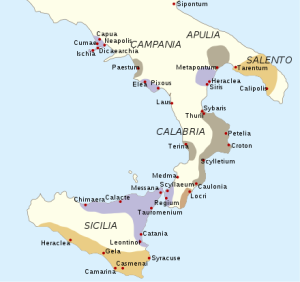 Sicily that were colonised by the Greeks, beginning as early as the 8th century BC. An interesting fact is that Philo of Alexandria (20 BC-50 AD) in his On the Eternity of the World(b) wrote “Are you ignorant of the celebrated account which is given of that most sacred Sicilian strait, which in old times joined Sicily to the continent of Italy?” (v.139). The name ‘Italy’ was normally used in ancient times to describe the southern part of the peninsula(d). Some commentators think that Philo was quoting Theophrastus, Aristotle’s successor. This would push the custom of referring to Italy as a ‘continent’ back to the time of Plato. More recently, Armin Wolf (1935- ), the German historian, when writing about Scheria relates(a) that “Even today, when people from Sicily go to Calabria (southern Italy) they say they are going to the “continente.” This continuing usage is confirmed by a current travel site(c). I suggest that Plato used the term in a similar fashion and can be seen as offering a more rational explanation for the use of the word ‘continent’ in Timaeus 25a, adding to the idea of Atlantis in the Central Mediterranean.
Sicily that were colonised by the Greeks, beginning as early as the 8th century BC. An interesting fact is that Philo of Alexandria (20 BC-50 AD) in his On the Eternity of the World(b) wrote “Are you ignorant of the celebrated account which is given of that most sacred Sicilian strait, which in old times joined Sicily to the continent of Italy?” (v.139). The name ‘Italy’ was normally used in ancient times to describe the southern part of the peninsula(d). Some commentators think that Philo was quoting Theophrastus, Aristotle’s successor. This would push the custom of referring to Italy as a ‘continent’ back to the time of Plato. More recently, Armin Wolf (1935- ), the German historian, when writing about Scheria relates(a) that “Even today, when people from Sicily go to Calabria (southern Italy) they say they are going to the “continente.” This continuing usage is confirmed by a current travel site(c). I suggest that Plato used the term in a similar fashion and can be seen as offering a more rational explanation for the use of the word ‘continent’ in Timaeus 25a, adding to the idea of Atlantis in the Central Mediterranean.
Giuseppe Palermo in his 2012 book Atlantide degli italiani is now bravely promoting the idea that Plato’s Atlantis was originally located beneath the town of Acri and the surrounding region of Calabria. He supports his claim by matching measurements provided by Plato with physical features around Acri(e). However surprising this idea may seem, it should be pointed out that according to Plato, Atlanteans had occupied southern Italy as far north as Tyrrhenia (Timaeus 25b & Critias 114c). If all this is not true, as a second prize, Acri can at least claim to be the birthplace of the famous American bodybuilder, Charles Atlas!
The Greeks began their gradual expansion westward between the 9th and 6th centuries BC, a development clearly illustrated on an excellent series of online maps(h). Understandably, they would have taken the shortest route from the Greek mainland to the heel of Italy and later on to Sicily. As they progressed with their colonisation new limits were set, and in time, exceeded. I suggest that these limits were each in turn designated the ‘Pillars of Heracles’ as they expanded. I speculate that Capo Colonna (Cape of the Column) in Calabria may have been one of those boundaries. Interestingly, 18th-century maps show up to five islands near the cape that are no longer visible(g), suggesting the possibility that in ancient times they could have been even more extensive, creating a strait that might have matched Plato’s description. On the other hand, the Strait of Messina was one of the locations recorded as the site of the ‘Pillars’ and considering that mariners at that time preferred to hug the coast, I would opt for the Strait of Messina rather than the more frequently proposed Strait of Sicily. A strait is defined as a narrow sea passage, a description that seems inappropriate for the 96 miles that separate Sicily from Tunisia.
For a brief history of the rise and fall of Magna Graecia, have a look at the classical wisdom website(f).
It is also noteworthy that there are a number of towns in Calabria where ancient Greek is still spoken(i). Similarly, back on the Peloponnese, the language of Sparta, Tsakonika, is still spoken by about 2,000 people in an area limited to 13 towns, villages and hamlets located around the village of Pera Melana(j).
(a) Wayback Machine (archive.org)
(b) http://www.earlychristianwritings.com/yonge/book35.html
(c) Four Ways to Do Sicily – Articles – Departures (archive.org)
(d) https://profilbaru.com/article/Name_of_Italy *
(e) https://www.atlantid.info/?page_id=539
(f) See: https://web.archive.org/web/20180824200049/https://classicalwisdom.com/magna-graecia-greater-greece/
(g) https://www.academia.edu/1152285/Discovery_of_Ancient_Harbour_Structures_in_Calabria_Italy_and_Implications_for_the_Interpretation_of_Nearby_Sites
(h) See: https://web.archive.org/web/20141105204103/https://learningobjects.wesleyan.edu/greek_colonies/
(i) http://www.madeinsouthitalytoday.com/mysterios-places.php
(j) BBC – Travel – The last speakers of ancient Sparta
Pilloni, Emanuela Katia
 Emanuela Katia Pilloni, an archaeologist, has written an article(a) , in Italian, supporting the idea that the identification of Sardinia with Atlantis should be reviewed. Dr. Pilloni supports Sergio Frau in locating the Pillars of Heracles at the Strait of Sicily. A copy of the original as well as a poor English machine- translation is available(b).
Emanuela Katia Pilloni, an archaeologist, has written an article(a) , in Italian, supporting the idea that the identification of Sardinia with Atlantis should be reviewed. Dr. Pilloni supports Sergio Frau in locating the Pillars of Heracles at the Strait of Sicily. A copy of the original as well as a poor English machine- translation is available(b).
(a) https://emanuelakatiapilloni.altervista.org/atlantide-e-la-sardegna/
*(b) See: Archive 3925*
Lilliu, Giovanni (t)
Giovanni Lilliu (1914-2012) was a highly respected Sardinian archaeologist and politician. He was  also a recognised expert on the Nuraghic culture of Sardinia. His contribution to the Atlantis debate is to locate the Pillars of Heracles at the Strait of Sicily or more precisely at Cape Bon in Tunisia and Lilybaeum in Sicily.
also a recognised expert on the Nuraghic culture of Sardinia. His contribution to the Atlantis debate is to locate the Pillars of Heracles at the Strait of Sicily or more precisely at Cape Bon in Tunisia and Lilybaeum in Sicily.
Graham Island
Graham Island was named by the British after Sir James Graham, the First Lord of the Admiralty, when the British planted their flag on it after it last appeared above the waves in 1831. Their claim was disputed by the French (who called it Julia), Spanish and the King Ferdinand II of the Two Sicilies (Sicily & Naples) after whom it was named Ferdinandea. Fortunately, conflict was avoided when the island disappeared within a year(a).
Graham Island situated in the Strait of Sicily is one of a number of volcanic islands that have been created by underwater eruptions. Frequently they only last above water for a short period, eventually sinking back under the sea. These events are frequently cited as an explanation for the demise of Atlantis. However, a cursory examination of the facts show that such a comparison is untenable. First of all the island of Atlantis described by Plato is quite extensive containing a large plain surrounded by mountains plus a varied range of flora and fauna. Secondly, the island of Atlantis had been inhabited for a considerable period and finally Atlantis according to Plato was destroyed by an earthquake not volcanic action. We have never had a record of a very large, long established island being destroyed by a volcano.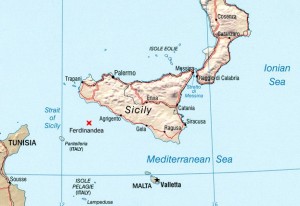
At present, the remains of Graham Island lie just 20 feet below sea level and in 2000 and 2002 have again shown signs of activity. In 1986, today’s masters of high-tech warfare, the United States, mistook the sunken remains of the island for a Libyan submarine and dropped depth charges on it!
>In July 2021, the BBC published a new detailed account of the rise and fall of Graham Island(b).<
(a) https://en.wikipedia.org/wiki/Ferdinandea
>(b) The Mediterranean’s short-lived ‘Atlantis’ – BBC Future<

